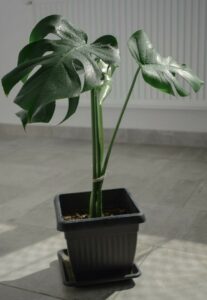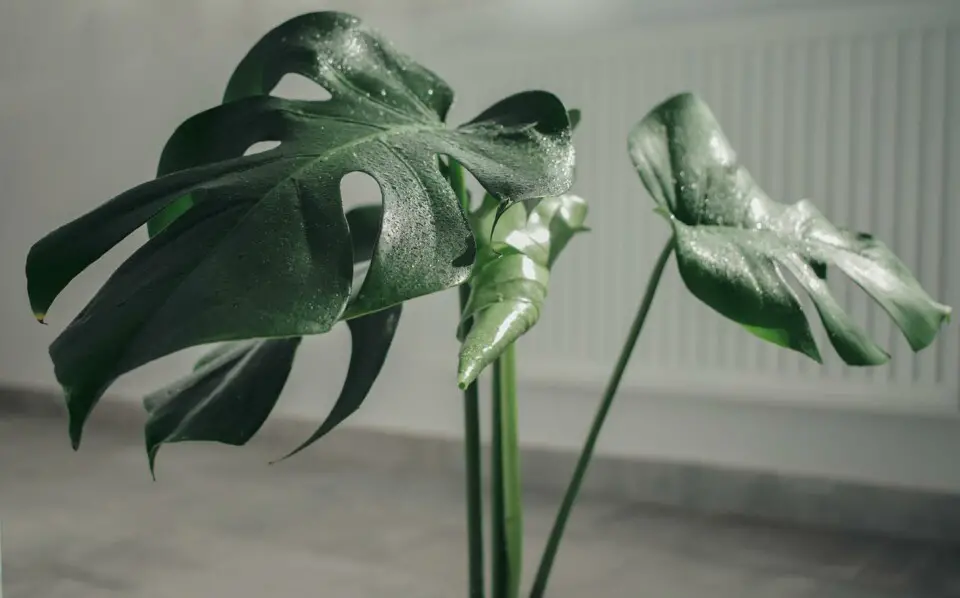Some links in the post are affiliate links and I get a commission from purchases made through some links found in the post.
The one thing that makes the monstera an avid grower and an ideal houseplant also adds to its maintenance needs. What do I mean by this?
When I started looking for a plant that would add some green allure to my space, I was eager to find one that would grow fast and fill up what I felt was an empty room.
So, when someone told me that the monstera developed a new leaf every four weeks, I was over the moon.
The monstera is not a small plant; one new leaf from this beauty almost equals ten from other normal-sized plants. At first, the journey was quite fun.
The plant kept growing bigger, and I was thrilled. But then, eventually, it started taking on a weaker stance and almost looked like it would topple.
It turned out that my monstera needed extra support, and I now had to learn how to offer it this.
I chose a moss pole because many gardeners had successfully used it as a support, and I will show you how I achieved this and the benefits of the same.
A moss pole provides support for your monstera. It also allows the aerial roots to attach to allow them to grow vertically. The best way to attach a moss pole is to wait until your monstera needs repotting, then stake the pole being careful of the roots and then ensure the plant has contact with the pole.
Does My Monstera Need a Moss Pole?
 When I bought my monstera, I only looked at what it needed regarding soil, water, and light. And I hacked these needs so much that the plant was ever-growing.
When I bought my monstera, I only looked at what it needed regarding soil, water, and light. And I hacked these needs so much that the plant was ever-growing.
But I forgot that I had to replicate almost everything the plant enjoyed in the wild. And one of these needs was support.
In the wild, the monstera grows among trees whose trunks act as its support. The plant then develops aerial roots which adhere to these trunks, creating a solid base and allowing it to scale vertically.
But my house had none of that, and I had to step in and provide this foundation. The alternative was to see all my hard work go to waste because my plant could no longer support its growth.
Does this mean my plant would have died? Not quite. An unsupported monstera either falls over or starts growing horizontally rather than growing taller. So, I could have opted to cut it back but instead chose to rely on a moss pole.
What is a moss pole? There’s a lot of information about what makes a pole a moss pole. A moss pole is simply a pole covered in moss.
The pole can be made of any material, but most people often use wood or PVC as the base. They then follow up with sphagnum peat moss (best option) to cover the pole, and voila, they have a moss pole!
Now, here is the interesting part. The pole is not a stake, as you might think. Instead, it is a medium onto which the aerial roots of the monstera can attach and use to grow vertically.
It comes down to the fact that monsteras are epiphytes and rely on such growth to reach upper sections of the forest where they can access light.
Some theories suggest that these plants use such mechanisms to avoid getting trampled on the ground by animals. But you get the idea here and how a moss pole fits into the picture.
Benefits of Using Moss Poles
Before adding anything to your plant’s care routine, you should ask yourself whether the added maintenance is worth it. So, what benefits accrue from using a moss pole?
- Your plant grows upright rather than falling over or taking on a horizontal growth pattern,
- The monstera does not sag as it gets heavier with age,
- The plant keeps producing healthy leaves because vertical growth allows it to reach more light, and
- The plant has a much better aesthetic value. We can all agree that climbing plants look much better when guided than when growing all over the place.
I was happy with these pros but also had to look at the cons.
Are There Any Concerns with Using Moss Poles?
I’d like to say that using a moss pole is the best decision you can ever make for your monstera. While this action comes with a range of benefits, you should also consider that:
- Poles can damage the roots of the monstera if not installed correctly. They can also adversely affect the drainage in the soil by creating a hole in which the water can settle rather than getting absorbed by the soil.
- Poles can encourage bug infestations: Moss poles are often kept moist to replicate forest tree environs, creating a suitable habitat for most pests. You will thus need to actively look out for and deal with any signs of pest infestation. Many gardeners have suffered some relief by using neem oil on the poles.

Also, note that some poles are generally weak and will give in to pressure, thus impacting the growth of your monstera. They can either break or bend, with the latter option harming the aesthetic value of trained growth.
You must, therefore, ensure you get a sturdy pole, install it like I will show you in this guide, and give your plant what it needs to keep pests at bay.
Will A Monstera Climb a Moss Pole?
You might think that your monstera will start climbing the moss pole as soon as you have positioned it. However, the plant takes its time to acclimate to its new support.
In most cases, the plant starts attaching to the moss pole a few weeks after positioning. This process should not take longer than six weeks. But this depends on:
Whether the Pole is Moist
The pole should be consistently moist to allow the aerial roots to attach to it. This moisture is akin to what a forest tree would exhibit, encouraging the aerial roots to take to it.
Else, the attachment could take a much longer time. To keep the pole moist, you can use a wicking system for the pole or increase the humidity around the plant.
Please note that keeping the pole moist reduces its lifespan. But that’s a considerable price since it encourages faster training.
Whether the Plant is Actively Growing
The monstera will not constantly grow at a fast and healthy rate. In the colder months, it suffers a bit of a setback in its growth, and you must wait until the weather warms up for the plant to start growing again.
So, the best time to use a moss pole would be spring and summer.
After a few weeks (provided you have met the criteria above), you can check if the monstera has attached to the moss pole.
The easiest way to do this is by removing some of the fasteners and checking if the plant still clings to the pole.
If it remains in place, the attachment was a success. If not, the plant still needs more time to attach to the plant or may not have the ideal attachment conditions, i.e., active growing period and moist pole.
I advise you to wait at least four weeks before checking if the plant has taken to the pole. Else, you could interrupt the process and start again from square one.
How To Pick a Moss Pole
Is picking a moss pole that big a task? Not even close. The process is straightforward and comes down to these steps:
1) You must consider the length of your plant from the pot’s base going up because the pole should be as tall or even taller as the plant.
It allows the plant to attach to it for a considerable while before replacing the pole. If you can, use an extendable pole which you can adjust as the plant grows.
It will save you money and keep you from disrupting the soil whenever the plant needs more support.
2) Consider the material used to make the pole. Wooden moss poles are easy to work with as you can insert them into the soil without much fuss.
Plus, you can use them with different poles, too, when you need to stack the poles in the future. PVC options are just as good and work even better when used to cover wooden poles to add to the sturdiness of the poles.
3) Choose a pole that can handle the weight of the monstera by assessing its height and thickness. You can always stack more poles for added support.
4) Go for sphagnum peat moss as it is most like the nature of the barks on forest trees.
5) Look into whether the pole comes with accessories like plant labels, tapes, and ties to help you attach the monstera. These are some add-ons that can make all the difference regarding the cost of supporting your plant.
The other thing to consider is the beauty of the pole. Most poles have a light brown to dark brown hue.
The lighter-colored ones are often more flexible because they have not undergone drying, while the darker ones are slightly more rigid. Choose what goes hand-in-hand with your aesthetic needs and work with it.
How Do I Attach a Monstera to a Moss Pole?
The best way to attach your monstera to a moss pole is to wait until your plant requires repotting. That makes it easier to stake the pole without affecting the soil around the monstera roots.
But if your plant does not need to be repotted, you cannot wait until it does to start this process. So, here’s how you can go about it:
- Find a moss pole that is easy to insert into the soil. It should have a tapered or pointed end that will go through the soil and cause minimal damage. Narrow options are the best at this point, and you can later seek thicker ones when repotting the plant.
- Wet the moss pole, then drive it into a location where the roots are few. You can aim for the edges of the pot where the roots may not be as extensive. If you feel that you cannot push the pole deeper into the soil, you have likely hit the roots. Consider if this depth is deep enough; if it’s not, look for another spot and drive the pole in again.
If you cannot find an ideal spot, you can always consider repotting the plant and starting afresh.
Repotting Monstera with a Moss Pole

Your monstera will react best to the moss pole if you attach it during repotting. That way, you can place the pole at the center of the potting mix before inserting the plant, as shown:
- Start by choosing a well-draining potting mix with medium texture to allow for adequate water retention,
- Fill the potting mix to a third of the pot’s height,
- Soak the moss pole in water to wet it, then insert it into the potting mix at a central point,
- Once the pole is secure, add the monstera and cover its roots with the rest of the potting mix, leaving two inches of space between the top of the pot and the height of the soil, and
- Gather the leaves and stems of the monstera and, using gardening ties, secure them to the pole at your preferred positions. Ensure they touch the moss on the pole.
That’s all you need to do. You can then sit and wait for the aerial roots to respond to the presence of moist moss and start adhering to it over time. Ensure you give your plant enough water, nutrients, and light in the meantime.
How To Train a Monstera with a Moss Pole
Is there anything you can do to fasten the adhering? Not really. All you can do is:
- Provide the plant with adequate water, nutrients, and light. You should water the plant whenever the top two inches of soil are dry, place it in bright and indirect light, and feed it in the spring. Please note that the growing needs depend on your specific type of monstera.
- Ensure the plant is in contact with the moss on the pole. You can use any fasteners for this job as long as they are soft and wide. Otherwise, the ties could drive into the plant’s stem and leaves and expose it to pests and diseases.
- When placing the ties, do so around the internodes where they will not hamper the development of aerial roots.
- Wet the moss pole often to keep it moist or add a humidifier into the room to moisten it.
You must also be patient with your plant and avoid loosening its ties prematurely.
For more help on a monstera with a moss pole, check out the video below
Final Thoughts
Remember to keep the moss pole moist, as this will push more aerial roots to adhere to it. Luckily, moss poles have high water retention rates and will hardly ever be dry.
Spray the moss pole with water each time you water the plant to keep it moist. Happy Gardening!

